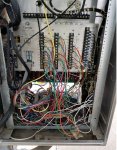Robert E
New User
- Location
- Atlanta Georgia
Can anyone provide me factual evidence that an arc flash event has actually occurred within a traffic signal cabinet operating at 110volts and injured a certified traffic signal technician? I have 25 years in the field and have worked with 2 Dept. of Transportation agencies and have partnered with larger nearby agencies to have a total of 125years experience and no one has ever seen this occur within a signal cabinet. ARC FLASH not a simple case of a small tingle from touching a terminal strip. I have responses from Caltrans Cal. DOT, and Texas DOT that indicate they have never had an experience with ARC FLASH since their formation. I firmly believe this is a case of OSHA lumping everyone into one category and not understanding what traffic signal technicians actually do. Our wire coming from the meter is a 6awg stranded conductor terminating behind a lexan shield and then going directly into a breakered panel within our cabinet. We then convert to 14awg wiring from that point throughout our enclosure. If we are required to wear gloves and such we will no longer be able to feel the wiring that we are dealing with and that means we could potentially flash an intersection simply by trying to perform regular maintenance and thus be sued personally for any subsequent accidents that we cause. In Ga. we do NOT have sovereign immunity anymore meaning techs are sued first and foremost personally then the local govt. agency. I appreciate any answers I receive on this matte but please remember I am speaking about traffic signal technicians and the liabilities that wearing large gloves and such pose to them and face shields that will keep them from being able to adequately see areas within the cabinet and perform the JOB safely. my attached images show what a typical cabinet would look like that techs would have to trace individual wires on in order to troubleshoot and you can see with gloves that would prove nearly impossible. my examples are typically a before and after scenario..... they are NOT the exact same location
.

.


